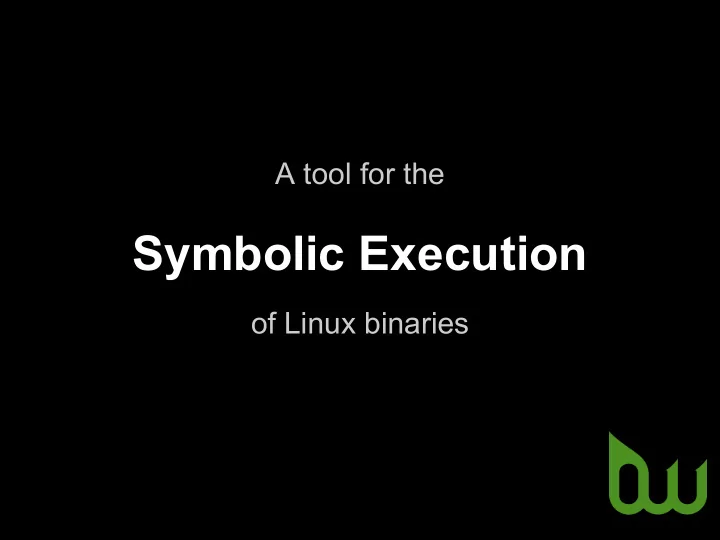

A tool for the Symbolic Execution of Linux binaries
About Symbolic Execution ● Dynamically explore all program branches. ● Inputs are considered symbolic variables. ● Symbols remain uninstantiated and become constrained at execution time. ● At a conditional branch operating on symbolic terms, the execution is forked. ● Each feasible branch is taken, and the appropriate constraints logged.
Input space >> Number of paths int main( ) { int val ; read(STDIN, & val , sizeof( val ) ); if ( val > 0 ) if ( val < 100 ) do_something( ); else do_something_else( ); }
This is used for: ● Test generation and bug hunting. ● Reason about reachability. ● Worst-Case Execution Time Analysis. ● Comparing different versions of a func. ● Deobfuscation, malware analisys. ● AEG: Automatic Exploit Generation. Whaat?!
State of the art ● Lots of academic papers: ○ 2008-12-OSDI-KLEE ○ Unleashing MAYHEM on Binary ● Several implementations: ○ SymDroid, Cloud9, Pex, jCUTE, Java PathFinder, KLEE, s2e, fuzzball, mayhem, cbass ● Only a few work on binary : ○ libVEX / IL based ○ quemu based
Our aim ● Emulate x86-64 machine code symbolically. ● Load ELF executables. ● Synthesize any process state as starting point. ● The final code should be readable and easy to extend. ● Use as few dependencies as possible: ○ pyelftools, distorm3 and z3 ● Analysis state can be saved and restored. ● Workload can be distributed (dispy)
Basic architecture
Instructions Frequency in GNU LIBC ● 336 different opcodes ● 160218 total instructions ● 37% of them are MOV or ADD ● currently 185 instruction implemented
CPU ● Based on distorm3 DecomposeInterface. ● Most instructions are very simple, ex. @instruction def DEC(cpu, dest): res = dest.write( dest.read() - 1 ) #Affected Flags o..szapc cpu.calculateFlags('DEC', dest.size, res)
Memory class Memory: def mprotect(self, start, size, perms): … def munmap(self, start, size): … def mmap(self, addr, size, perms): … def putchar(self, addr, data): … def getchar(self, addr): …
Operating System Model (Linux) class Linux: def exe(self, filename, argv=[], envp=[]):… def syscall(self, cpu):… def sys_open(self, cpu, buf, flags, mode):… def sys_read(self, cpu, fd, buf, count):… def sys_write(self, cpu, fd, buf, size):… def sys_close(self, cpu, fd):… def sys_brk(self, cpu, brk):…
Symbols and SMT solver class Solver: def getallvalues(self, x, maxcnt = 30): def minmax(self, x, iters=10000): def check(self): def add(self, constraint): #Symbols factory def mkArray(self, size, name ): … def mkBool(self, name ): … def mkBitVec(self, size, name ): …
Operation over symbols is almost transparent >>> from smtlibv2 import * >>> s = Solver() >>> a = s.mkBitVec(32) >>> b = s.mkBitVec(32) >>> s.add( a + 2*b > 100 ) >>> s.check() 'sat' >>> s.getvalue(a), s.getvalue(b) ( 101 , 0 )
The glue: Basic Initialization 1. Make Solver, Memory, Cpu and Linux objects. 2. Load ELF binary program in Memory, Initialize cpu registers, initialize stack. solver = Solver() mem = SMemory(solver, bits, 12 ) cpu = Cpu(mem, arch ) linux = SLinux(solver, [cpu], mem, ... ) linux.exe(“./my_test”, argv=[], env=[])
The glue: Basic analysis loop states = [‘init.pkl’] while len(states) > 0 : linux = load(state.pop()) while linux.running: linux.execute() if isinstance( linux.cpu.PC, Symbol): vals = solver.getallvalues(linux. cpu.PC) -- generate states for each value -- break
Micro demo python system.py -h usage: system.py [-h] [-sym SYM] [-stdin STDIN] [-stdout STDOUT] [-stderr STDERR] [-env ENV] PROGRAM ... python system.py -sym stdin my_prog stdin: PDF-1.2++++++++++++++++++++++++++++++
Symbolic inputs. We need to mark whic part of the environment is symbolic: ● STDIN: a file partially symbolic. Symbols marked with “+” ● STDOUT and STDERR are placeholders. ● ARGV and ENVP can be symbolic
A toy example int main(int argc, char* argv[], char* envp[]){ char buffer [0x100] = {0}; read(0, buffer , 0x100); if (strcmp( buffer , "ZARAZA") == 0 ) printf("Message: ZARAZA!\n"); else printf("Message: Not Found!\n"); return 0; }
Conclusions, future work ● Push all known optimizations: solver cache, implied values, Redundant State Elimination, constraint independence, KLEE-like cex cache, symbol simplification. ● Add more cpu instructions (fpu, simd). ● Improve Linux model, add network. ● Implement OSX loader and os model. ● https://github.com/feliam/pysymemu
g Gracias. Contacto: feliam@binamuse.com
Recommend
More recommend